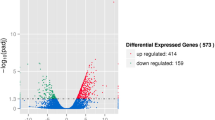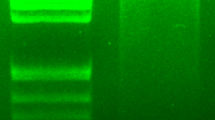Abstract
Elongation factors (EF) are abundant cell proteins that play important roles in the metabolism of all multicellular organisms. Here we describe a functional analysis of elongation factor 1-alpha (EF1A) and elongation factor 2 (EF2), from the Pacific white shrimp, Litopenaeus vannamei. Full-length cDNAs of genes corresponding to EF1A and EF2 were obtained that were 1547 and 2729 bp long, with open reading frames encoding 461 and 846 amino acids, respectively. The deduced amino acid sequences of L. vannamei EF1A and EF2 showed high similarity with those from mice, humans, chickens and other shrimps. RT-PCR analysis indicated that mRNA transcripts of EF1A and EF2 are strongly (but differentially) expressed in haemocytes and gill tissue, and at varying levels in other examined tissues, of the shrimps. Levels of both EF1A and EF2 transcripts increased when shrimps were challenged by pH and cadmium stress, but reached maximal levels after different exposure periods. These results indicate that EF1A and EF2 may play distinct, essential roles in the repair of cellular damage induced by pH and cadmium stress.








Similar content being viewed by others
References
Halliwell B, Gutteridge JMC (1999) Antioxidant defenses. In: Halliwell B, Gutteridge JMC (eds) Free radicals in biology and medicine, 3rd edn. Oxford University Press, New York, p 175
Wang WN, Zhou J, Wang P, Tian TT, Zheng Y, Liu Y, Mai WJ, Wang AL (2009) Oxidative stress, DNA damage and antioxidant enzyme gene expression in the Pacific white shrimp, Litopenaeus vannamei when exposed to acute pH stress. Comp Biochem Physiol C 150:428–435
Figueiredo-Pereira ME, Yakushin S, Cohen G (1997) Accumulation of ubiquitinated proteins in mouse neuronal cells induced by oxidative stress. Mol Biol Rep 24:35–38
Chang M, Wang WN, Wang AL, Tian TT, Wang P, Zheng Y, Liu Y (2009) Effects of cadmium on respiratory burst, intracellular Ca2+ and DNA damage in the white shrimp Litopenaeus vannamei. Comp Biochem Physiol C 149:581–586
Hegde ML, Hazra TK, Mitra S (2008) Early steps in the DNA base excision/single-strand interruption repair pathway in mammalian cells. Cell Res 18:27–47
Holcik M, Sonenberg N (2005) Translational control in stress and apoptosis. Nat Rev Mol Cell Biol 6:318–327
Andersen GR, Nissen P, Nyborg J (2003) Elongation factors in protein biosynthesis. Trends Biochem Sci 28:434–441
Nilsson J, Nissen P (2005) Elongation factors on the ribosome. Curr Opin Struct Biol 15:349–354
Proud CG (1994) Peptide-chain elongation in eukaryotes. Mol Biol Rep 19:161–170
Yang F, Demma M, Warren V, Dharmawardhane S, Condeelis J (1990) Identification of an actin-binding protein from Dictyostelium as elongation factor 1α. Nature 347:494–496
Negrutskii BS, El’skaya AV (1998) Eukaryotic translation elongation factor 1α: structure, expression, functions and possible role in aminoacyl-tRNA channeling. Prog Nucleic Acid Res Mol Biol 60:47–78
Lamberti A, Caraglia M, Longo O, Marra M, Abbruzzese A, Arcari P (2004) The translation elongation factor 1A in tumorigenesis, signal transduction and apoptosis: review article. Amino Acids 26:443–448
Chen E, Proestou G, Bourbeau D, Wang E (2000) Rapid up-regulation of peptide elongation factor EF-1 alpha protein levels in an immediate early event during oxidative stress-induced apoptosis. Exp Cell Res 259:140–148
Kim EK, Lee SJ, Moon SH, Jeon BT, Ahn CB, Kim B, Lim BO, Park PJ (2009) Free radical scavenging activity and comparative proteomic analysis of antioxidative protein against H2O2-induced oxidative stress in neuronal cells. Food Chem 117:232–240
Qiu L, Jiang S, Zhou F, Zhang D, Huang J, Guo Y (2008) Molecular cloning of the black tiger shrimp (Penaeus monodon) elongation factor 2 (EF-2): sequence analysis and its expression on the ovarian maturation stage. Mol Biol Rep 35:431–438
Zhou J, Wang WN, Ma GZ, Wang AL, He WY, Wang P, Liu Y, Liu JJ, Sun RY (2008) Gene expression of ferritin in tissue of the Pacific white shrimp, Litopenaeus vannamei after exposure to pH stress. Aquaculture 275:356–360
Livak KJ, Schmittgen TD (2001) Analysis of relative gene expression data using realtime quantitative PCR and the 2(-Delta Delta C(T)) method. Methods 25:402–408
Viarengo A (1990) Heavy metal effects on lipid peroxidation in the tissues of Mytilus galloprovincialis Lam. Comp Biochem Physiol C 97:37–42
Freire CA, Onken H, McNamara JC (2008) A structure–function analysis of ion transport in crustacean gills and excretory organs. Comp Biochem Physiol A 151:272–304
Rattan SIS (1996) Synthesis, modifications, and turnover of proteins during aging. Exp Gerontol 31:33–47
Merrick W, Nyborg J (2000) The protein synthesis elongation cycle. In: Hershey J, Mathews M (eds) Translational control of gene expression. CSHL Press, New York, pp 89–125
Ayala A, Parrado J, Bougria M, Machado A (1996) Effect of oxidative stress, produced by cumene hydroperoxide, on the various steps of protein synthesis. Modifications of elongation factor-2. J Biol Chem 271:23105–23110
Galliea DR, Lea H, Caldwella C, Browningb KS (1998) Analysis of translation elongation factors from wheat during development and following heat shock. Biochem Biophys Res Commun 245:295–300
Sans MD, Xie Q, Williams JA (2004) Regulation of translation elongation and phosphorylation of eEF2 in rat pancreatic acini. Biochem Biophys Res Commun 319:144–151
Weinberg RA (1996) EF2 and cell proliferation: a world turned upside down. Cell 85:457–459
Zhu G, Yan W, He HC, Bi XC, Han ZD, Dai QS, Ye YK, Liang YX, Wang JY, Zhong HD (2009) Inhibition of proliferation, invasion, and migration of prostate cancer cells by down-regulating elongation factor-1 alpha expression. Mol Med 15:367–370
Duttaroy A, Bourbeau D, Wang XL, Wang E (1998) Apoptosis rate can be accelerated or decelerated by overexpression or reduction of the level of elongation factor-1A. Exp Cell Res 238:168–176
Ruest LB, Marcotte R, Wang G (2002) Peptide elongation factor eEF1A expression in cultured differentiated myotubes and its protective effect against caspase-3-mediated apoptosis. J Biol Chem 277:5418–5425
Zelivianski S, Liang D, Chen M, Mirkin BL, Zhao RY (2006) Suppressive effect of elongation factor 2 on apoptosis induced by HIV-1 viral protein R. Apoptosis 11:377–388
Hotokezaka Y, Többen U, Hotokezaka H, Leyen KV, Beatrix B, Smith DH, Nakamura T, Wiedmann M (2002) Interaction of the eukaryotic elongation factor 1A with newly synthesized polypeptides. J Biol Chem 277:18545–18551
Gonen H, Dickman D, Schwartz AL, Ciechanover A (1996) Protein synthesis elongation factor EF-1 alpha is an isopeptidase essential for ubiquitin-dependent degradation of certain proteolytic substrates. Adv Exp Med Biol 389:209–219
Ransom-Hodgkins WD, Brglez I, Wang X, Boss WF (2000) Calcium-Regulated Proteolysis of eEF1A. Plant Physiol 122:957–965
Feijó JA, Sainhas, Hacket GR, Kunkel JG, Hepler PK (1999) Growing pollen tubes possess a constitutive alkaline band in the clear zone and a growth-dependent acidic tip. J Cell Biol 144:483–496
Zhou J, Wang WN, Wang AL, He WY, Zhou QT, Liu Y, Xu J (2009) Glutathione S-transferase in the white shrimp Litopenaeus vannamei: characterization and regulation under pH stress. Comp Biochem Physiol C 150:224–230
Acknowledgments
This research was supported by the National Natural Science Foundation of China (Grant nos. 30570287 and 30970455), and the Natural Science Foundation of the Guangdong Province in the P.R. China (Grant nos. 06025052 and 8151063101000035), and Guangdong Provincial Oceanic Fisheries Science and Technology Project (Grant no. A200899D01) and the Project of the Department of Education of Guangdong Province for the Young Researcher of Higher School. We are grateful for the help of Profs. Qili Feng and Sichun Zheng from the laboratory of Molecular Entomology, South China Normal University.
Author information
Authors and Affiliations
Corresponding author
Additional information
Lei Wang, Yuan Liu contributed equally to this work.
Rights and permissions
About this article
Cite this article
Wang, L., Liu, Y., Wang, WN. et al. Molecular characterization and expression analysis of elongation factors 1A and 2 from the Pacific white shrimp, Litopenaeus vannamei . Mol Biol Rep 38, 2167–2178 (2011). https://doi.org/10.1007/s11033-010-0345-2
Received:
Accepted:
Published:
Issue Date:
DOI: https://doi.org/10.1007/s11033-010-0345-2




